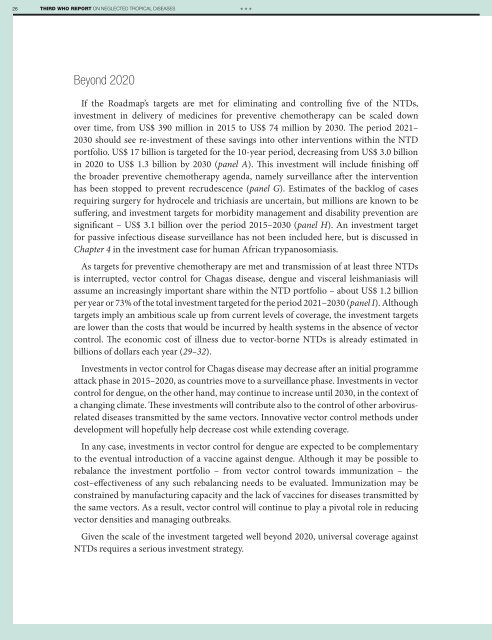1A9bnbK
1A9bnbK
1A9bnbK
Create successful ePaper yourself
Turn your PDF publications into a flip-book with our unique Google optimized e-Paper software.
26 THIRD WHO REPORT ON NEGLECTED TROPICAL DISEASES<br />
***<br />
Beyond 2020<br />
If the Roadmap’s targets are met for eliminating and controlling five of the NTDs,<br />
investment in delivery of medicines for preventive chemotherapy can be scaled down<br />
over time, from US$ 390 million in 2015 to US$ 74 million by 2030. The period 2021–<br />
2030 should see re-investment of these savings into other interventions within the NTD<br />
portfolio. US$ 17 billion is targeted for the 10-year period, decreasing from US$ 3.0 billion<br />
in 2020 to US$ 1.3 billion by 2030 (panel A). This investment will include finishing off<br />
the broader preventive chemotherapy agenda, namely surveillance after the intervention<br />
has been stopped to prevent recrudescence (panel G). Estimates of the backlog of cases<br />
requiring surgery for hydrocele and trichiasis are uncertain, but millions are known to be<br />
suffering, and investment targets for morbidity management and disability prevention are<br />
significant – US$ 3.1 billion over the period 2015–2030 (panel H). An investment target<br />
for passive infectious disease surveillance has not been included here, but is discussed in<br />
Chapter 4 in the investment case for human African trypanosomiasis.<br />
As targets for preventive chemotherapy are met and transmission of at least three NTDs<br />
is interrupted, vector control for Chagas disease, dengue and visceral leishmaniasis will<br />
assume an increasingly important share within the NTD portfolio – about US$ 1.2 billion<br />
per year or 73% of the total investment targeted for the period 2021–2030 (panel I). Although<br />
targets imply an ambitious scale up from current levels of coverage, the investment targets<br />
are lower than the costs that would be incurred by health systems in the absence of vector<br />
control. The economic cost of illness due to vector-borne NTDs is already estimated in<br />
billions of dollars each year (29–32).<br />
Investments in vector control for Chagas disease may decrease after an initial programme<br />
attack phase in 2015–2020, as countries move to a surveillance phase. Investments in vector<br />
control for dengue, on the other hand, may continue to increase until 2030, in the context of<br />
a changing climate. These investments will contribute also to the control of other arbovirusrelated<br />
diseases transmitted by the same vectors. Innovative vector control methods under<br />
development will hopefully help decrease cost while extending coverage.<br />
In any case, investments in vector control for dengue are expected to be complementary<br />
to the eventual introduction of a vaccine against dengue. Although it may be possible to<br />
rebalance the investment portfolio – from vector control towards immunization – the<br />
cost–effectiveness of any such rebalancing needs to be evaluated. Immunization may be<br />
constrained by manufacturing capacity and the lack of vaccines for diseases transmitted by<br />
the same vectors. As a result, vector control will continue to play a pivotal role in reducing<br />
vector densities and managing outbreaks.<br />
Given the scale of the investment targeted well beyond 2020, universal coverage against<br />
NTDs requires a serious investment strategy.


